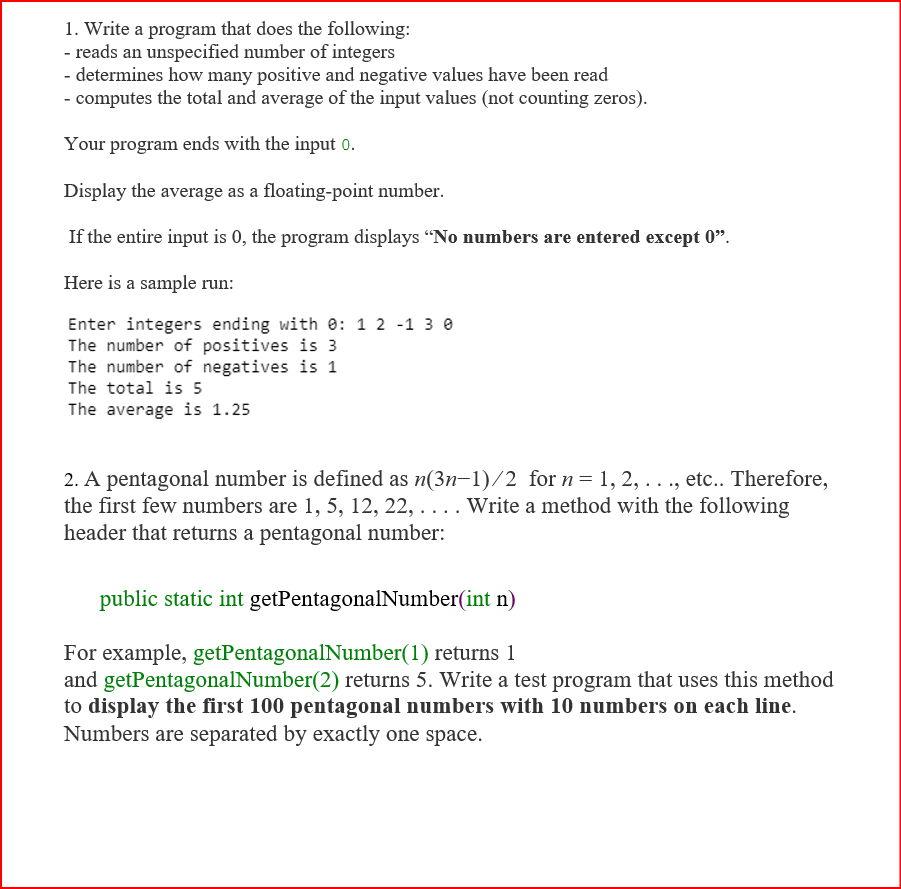1. Write a program that does the following: - reads an unspecified number of integers - determines how many positive and negative values have been read - computes the total and average of the input values (not counting zeros). Your program ends with the input 0. Display the average as a floating-point number. If the entire input is 0, the program displays "No numbers are entered except 0". Here is a sample run: Enter integers ending with e: 1 2 -1 3 e The number of positives is 3 The number of negatives is 1 The total is 5 The average is 1.25 2. A pentagonal number is defined as n(3n-1)/2 for n= 1, 2, . . ., etc.. Therefore, the first few numbers are 1, 5, 12, 22, . . ..Write a method with the following header that returns a pentagonal number: public static int getPentagonalNumber(int n) For example, getPentagonalNumber(1) returns 1 and getPentagonalNumber(2) returns 5. Write a test program that uses this method to display the first 100 pentagonal numbers with 10 numbers on each line. Numbers are separated by exactly one space.
1. Write a program that does the following: - reads an unspecified number of integers - determines how many positive and negative values have been read - computes the total and average of the input values (not counting zeros). Your program ends with the input 0. Display the average as a floating-point number. If the entire input is 0, the program displays "No numbers are entered except 0". Here is a sample run: Enter integers ending with e: 1 2 -1 3 e The number of positives is 3 The number of negatives is 1 The total is 5 The average is 1.25 2. A pentagonal number is defined as n(3n-1)/2 for n= 1, 2, . . ., etc.. Therefore, the first few numbers are 1, 5, 12, 22, . . ..Write a method with the following header that returns a pentagonal number: public static int getPentagonalNumber(int n) For example, getPentagonalNumber(1) returns 1 and getPentagonalNumber(2) returns 5. Write a test program that uses this method to display the first 100 pentagonal numbers with 10 numbers on each line. Numbers are separated by exactly one space.
C++ Programming: From Problem Analysis to Program Design
8th Edition
ISBN:9781337102087
Author:D. S. Malik
Publisher:D. S. Malik
Chapter5: Control Structures Ii (repetition)
Section: Chapter Questions
Problem 30PE
Related questions
Question

Transcribed Image Text:1. Write a program that does the following:
- reads an unspecified number of integers
- determines how many positive and negative values have been read
- computes the total and average of the input values (not counting zeros).
Your program ends with the input 0.
Display the average as a floating-point number.
If the entire input is 0, the program displays "No numbers are entered except 0".
Here is a sample run:
Enter integers ending with e: 1 2 -1 3 e
The number of positives is 3
The number of negatives is 1
The total is 5
The average is 1.25
2. A pentagonal number is defined as n(3n-1)/2 for n= 1, 2, ..., etc.. Therefore,
the first few numbers are 1, 5, 12, 22, .... Write a method with the following
header that returns a pentagonal number:
public static int getPentagonalNumber(int n)
For example, getPentagonalNumber(1) returns 1
and getPentagonalNumber(2) returns 5. Write a test program that uses this method
to display the first 100 pentagonal numbers with 10 numbers on each line.
Numbers are separated by exactly one space.
Expert Solution
This question has been solved!
Explore an expertly crafted, step-by-step solution for a thorough understanding of key concepts.
This is a popular solution!
Trending now
This is a popular solution!
Step by step
Solved in 2 steps

Recommended textbooks for you

C++ Programming: From Problem Analysis to Program…
Computer Science
ISBN:
9781337102087
Author:
D. S. Malik
Publisher:
Cengage Learning

C++ Programming: From Problem Analysis to Program…
Computer Science
ISBN:
9781337102087
Author:
D. S. Malik
Publisher:
Cengage Learning